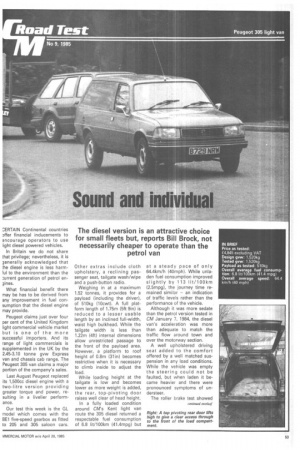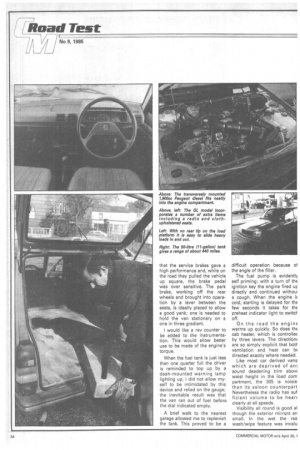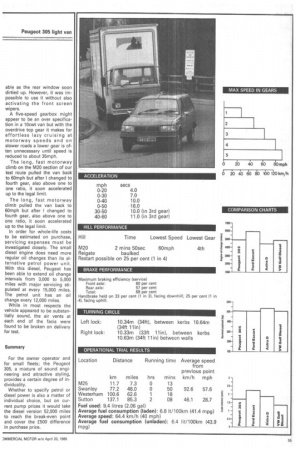The diesel version is an attractive choice for small fleets
Page 55

Page 56

Page 57

If you've noticed an error in this article please click here to report it so we can fix it.
but, reports Bill Brock, not necessarily cheaper to operate than the petrol van
MRTAIN Continental countries pffer financial inducements to encourage operators to use light diesel powered vehicles.
In Britain we do not share that privilege; nevertheless, it is generally acknowledged that he diesel engine is less harmful to the environment than the urrent generation of petrol engines.
What financial benefit there may be has to be derived from any improvement in fuel consumption that the diesel engine may provide.
Peugeot claims just over four per cent of the United Kingdom light commercial vehicle market but is one of the more successful importers. And its range of light commercials is supplemented in the UK by the 2.45-3.10 tonne gvw Express van and chassis cab range. The Peugeot 305 van claims a major portion of the company's sales.
Last August Peugeot replaced its 1,500cc diesel engine with a two-litre version providing greater torque and power, resulting in a livelier performance.
Our test this week is the GL model which comes with the BE1 five-speed gearbox as fitted Lo 205 and 305 saloon cars. Other extras include cloth upholstery, a reclining passenger seat, tailgate wash/wipe and a push-button radio.
Weighing in at a maximum 1.52 tonnes, it provides for a payload (including the driver), of 510kg (10cwt). A full platform length of 1.75m (51t 9in) is reduced to a lesser usable length by an inclined full-width, waist high bulkhead. While the tailgate width is less than 1.22m (4ft) internal dimensions allow unrestricted passage to the front of the payload area. However, a platform to roof height of 0.8m {31in) becomes restrictive when it is necessary to climb inside to adjust the load.
While loading height at the tailgate is low and becomes lower as more weight is added, the rear, top-pivoting door raises well clear of head height.
In a fully loaded condition around CM's Kent light van route the 305 diesel returned a respectable fuel consumption of 6.8 lit/100km (41.4mpg) but at a steady pace of only 64.4km/h (40mph). While unladen fuel consumption improved slightly by 113 lit/100km (2.5mpg), the journey time remained similar — an indication of traffic levels rather than the performance of the vehicle.
Although it was more sedate than the petrol version tested in CM January 7, 1984, the diesel van's acceleration was more than adequate to match the traffic flow around town and over the motorway section.
A well upholstered driving seat added to the comfort offered by a well matched suspension in any load conditions. While the vehicle was empty the steering could not be faulted, but when laden it became heavier and there were pronounced symptoms of understeer.
The roller brake test showed that the service brakes gave a high performance and, while on the road they pulled the vehicle up square, the brake pedal was over sensitive. The park brake, working off the rear wheels and brought into operation by a lever between the seats, is ideally placed to allow a good yank; one is needed to hold the van stationary on a one in three gradient.
I would like a rev counter to be added to the instrumentation. This would allow better use to be made of the engine's torque.
When the fuel tank is just less than one quarter full the driver is reminded to top up by a dash-mounted warning lamp lighting up. I did not allow myself to be intimidated by this device and relied on the gauge; the inevitable result was that the van ran out of fuel before the dial indicated empty.
A brief walk to the nearest garage allowed me to replenish the tank. This proved to be a difficult operation because al the angle of the filler.
The fuel pump is evidently self priming: with a turn of the ignition key the engine fired ur directly and continued withoui a cough. When the engine h cold, starting is delayed for the few seconds it takes for the preheat indicator light to switch off.
On the road the engine warms up quickly. So does the cab heater, which is controller by three levers. The direction; are so simply explicit that botf ventilation and heat can be directed exactly where needed.
Like most car derived vans which are deprived of an) sound deadening trim above waist height in the load corn partment, the 305 is noisie than its saloon counterpart Nevertheless the radio has suf ficient volume to be hear( clearly at all speeds.
Visibility all round is good al though the exterior mirrors an small. In the wet the rea wash/wipe feature was invalu able as the rear window soon dirtied up. However, it was impossible to use it without also activating the front screen wipers.
A five-speed gearbox might appear to be an over specification in a lOcwt van but with the overdrive top gear it makes for effortless lazy cruising at motorway speeds and on slower roads a lower gear is often unnecessary until speed is reduced to about 35mph.
The long, fast motorway climb on the M20 section of our test route pulled the van back to 60mph but after I changed to fourth gear, also above one to one ratio, it soon accelerated up to the legal limit.
The long, fast motorway climb pulled the van back to 60mph but after I changed to fourth gear, also above one to one ratio, it soon accelerated up to the legal limit.
In order for whole-life costs to be estimated on purchase, servicing expenses must be investigated closely. The small diesel engine does need more regular oil changes than its alternative petrol power unit. With this diesel, Peugeot has been able to extend oil change intervals from 3,000 to 5,000 miles with major servicing stipulated at every 15,000 miles. The petrol unit has an oil change every 12,000 miles.
While in most respects the vehicle appeared to be substantially sound, the air vents at each end of the facia were found to be broken on delivery for test.
Summary For the owner operator and for small fleets; the Peugeot 305, a mixture of sound engineering and attractive styling, provides a certain degree of individuality.
Whether to specify petrol or diesel power is also a matter of individual choice, but on current pump prices it would take the diesel version 52,000 miles to reach the break-even point and cover the £500 difference in purchase price.




















































































